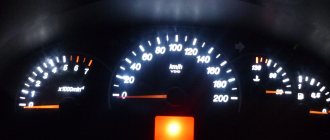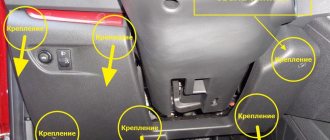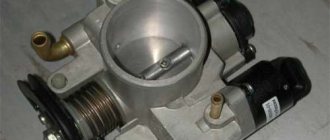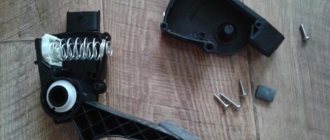Main fuse box Lada Priora
The bulk of the fuses on the Priora are located on the left under the steering column. The board is covered with a plastic cover, which is very easy to open by turning the three black latches that hold it in place. The cover itself is thrown aside and we see a diagram of fuses and relays located on the printed circuit board.
Fuse box
At the top of the board there are exclusively relays. They are necessary to turn on a powerful load, from several Amperes and above. In the lower part, there are fuses in two rows, painted in a variety of colors (this depends on their rating). For ease of removal of both fuses and relays, plastic puller pliers are provided on the right side of the block.
Lada Priora fuses are standardly marked with the English letter F, from the word Fuse (actually, fuse). Numbering goes from left to right. The first fuse in the top row is designated F1, and the last one is F32.
Not every fuse box is occupied; empty spaces are designated as reserve ones. In particular, on Priora these are cells F22-F30 and F32. The same applies to the spaces for the relay - not all of the existing spaces on the Lada Priora printed circuit board are used.
This unit is responsible for lighting the headlights (F3 and F4 - high beam; F6, F7 - low beam), and for interior lighting (F10), and for electrically heated seats (F19). In general, if there is a problem with the dimensions, any existing lighting of the Lada Priora, stove (F9), windshield wiper (F11), etc. – it’s worth checking the fuse links in the main fuse box. The same applies to executive relays, incl. starter relay (K3).
Video “Replacing the fuse box on a Priora”
The procedure for replacing the Priora fuse box is presented in a video from the “Repair and Tuning” channel.
We recommend watching:
- Priora high beam fuse
Where is the Priora wiper fuse located?- Priora abs fuse box
- Lada Priora starter fuse
Priora wiper relay where is it located?- Where is the fuse for the Priora central locking?
Additional fuse box located under the hood of Lada Priora
A certain part of the fuses on your car is hidden in the engine compartment, near the expansion tank. They are also covered on top with a black plastic casing, which will need to be removed to get to the Lada Priora fuse circuit located under its hood. Their number, of course, is nowhere near the number that fits in the main block. But that doesn’t make their importance any less important, because they are directly responsible for the operation of the internal combustion engine, cooling system fan, electric power steering and generator. If the Lada Priora does not start, it may well be that one of the fuses presented has failed.
Fuses under the hood
The Lada Priora fuses located in this block have the highest rating. If the “strongest” fuse-link in the main block is limited to 30 A, then the rated currents here are measured in values from 30 to 60 A, which is explained by the high pulse currents of the spark plugs, generator and other electrical current collectors of the internal combustion engine. You should not try to change the fuse of the Lada Priora while the power unit is running; currents of such magnitude can cause strong sparking when trying to remove the fuse-link under load or insert it; possible burns, slight fright and damage to the fuse-link block are almost guaranteed.
Lada Priora fuse box, located opposite the passenger seat
Finally, several more relays and fuses are located on the passenger side under the dash panel. The block cover is held in place by several self-tapping screws, which must be unscrewed with a Phillips screwdriver to gain access to the printed circuit board. The fuse circuit of the block includes only three fuse links and two relays on an additional flange mount.
This is where the main automotive relay (K1) is located. It is turned on by the electronic control unit after turning the ignition key and is responsible for the bulk of the sensors necessary for the normal operation of the power unit on the Lada Priora. You can tell that the relay has activated by a characteristic click after turning the ignition key.
The fuses in this circuit protect the operating circuit of the main relay (F1), the power circuit of the controller (F2), which controls the operation of the internal combustion engine, and the fuel pump switching line (F3). The fuel pump itself is turned on using a relay (K2) located there. The serviceability of all the above components is necessary to start the car and start moving, as well as the fuses located under the hood of the Lada Priora.
Priora mounting block - location and replacement of fuses
The electrical system of every car needs overload protection.
After all, faulty wiring is detrimental to the car. The most negative option is a fire in the wiring. As in all cars, in a Priora car the fuse block is designed to protect the wiring from overloads. It is equipped with fuses and relays. Relays are designed for equipment that requires high current to operate. Relays protect switch contacts from burnout.
Let's pay attention to how the fuse box diagram is arranged: Priora is equipped with fuses.
The principle of operation of such fuses is as follows: when a higher current than necessary passes through the fuse, the fuse located inside the fuse burns out, thereby opening the circuit. This simple operating principle saves the car’s electronics from breakdown.
Remember, any electronics in the car have failed: be it power windows, lights or electric seat heaters - do not rush to panic and go to a service center. Perhaps the only problem is that the fuse has done its job and opened the circuit.
Considering how this or that fuse box is located, the VAZ 2170 Priora allows the owner to carry out the replacement himself. But even if the fuse is really blown, do not rush to change it. Find out why this happened. There may be a short circuit in some part of the circuit. If it is not eliminated, then replacing the fuse will be of no use.
The electrical circuit installed in the Lada Priora car: fuse and relay box - allows you to protect your car from expensive repairs. It is important to understand the purpose of each of their elements in order to take appropriate measures.
If you have knowledge of how the fuse box works (in conjunction with how the entire car's electrical circuit is arranged), the Priora will become an open book for you.
In a Lada Priora car, there is not just one fuse block - there are several. There is one main block and three additional ones. The main one is located under the hood on the battery side. There are few fuses here. They are labeled from left to right and have the following meaning:
1) F1 (color green) – Electronic engine control system (60 A) 2) F2 (color green) – electrical accessories, electric engine fan, ignition switch load relay, heated rear window; (60 A)
3) F3 (orange color) – power supply for the cigarette lighter, brake light, interior light, instrument cluster, power supply for the cooling system fan, sound and alarm signals, as well as the ignition switch; (60 A) 4) F4 (color blue) – generator (60 A)
5) F5 (red color) – EUR (50 A) 6) F6 (blue color) – generator (60 A)
There is also a second fuse box under the hood. Having allocated an additional relay and fuse block to the air conditioning system, the Lada Priora came a little closer to foreign cars in terms of electrical reliability.
The block includes: fuses for the power supply circuit of the right and left electric fan (30 A each), electric heater fan (40 A) and compressor (15 A); relay for electric fan right and left, electric fan for heater and compressor.
The next block is behind the central panel. To do this, you need to dismantle the lining of the central panel on the right.
In the VAZ 2170 Priora car, the fuse box located behind the central panel is represented by a small block. The following fuses are installed there: for the main relay circuit and starter blocking (15 A), for powering the computer (7.5 A), for the electric fuel pump (15 A). A main relay and a relay for starting the fuel pump are also installed
The fourth fuse box in Priora is located on the driver's side, under the steering wheel on the left. The facing cover is secured with 3 screws. This block contains the most fuses.
What to do if the fuses in the circuit on a Lada Priora have burned out
Problems with a blown Lada Priora fuse can arise for the following reasons:
- malfunction in the power circuit: problems in the electrical wiring or in the main consumer;
- a defect or defect in the fuse-link, when it actually does not correspond to the declared rating and quickly burns out. Perhaps the problem is not in the circuit, but in the fuse itself;
- poor contact on the terminals of the printed circuit board with the fuse. Insufficient force at the junction of two conductors becomes the cause of the so-called. transition resistance. At the point of poor contact, the fuse becomes very hot, which causes premature burnout of the fuse link. Make sure the fuse blades are securely seated.
Blown fuse
Fuses can blow either instantly or after some time in operation, as understood:
- if the fuse burns out immediately after installing it in the circuit, this is a sure sign of either a short circuit, or you are installing a fuse link of a lower rating in the block. Such behavior of the fuse most likely hints at a problem in the electrical circuit;
- if the fuse-link burns out after some time: after a couple of minutes of operation, half an hour or several hours, this means that there is an overcurrent. The greater the overload, the faster the fuse blows. As we said above, a possible reason could be poor production quality, high contact resistance, operation of the electrical receiver in overload mode, and problems with the electrical circuit of the Lada Priora.
Under no circumstances should you change the fuse rating while trying to experiment with the load current. In normal operation, the setting current is selected slightly higher than the operating current, which provides effective protection of the electrical circuit from both overloads and short circuits. Changing the operating parameters of an electrical circuit can cause not only failure of the line protected by the fuse, but also other elements of the electrical wiring.











